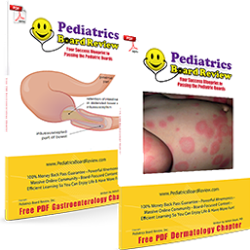Frequently Asked Questions About MOCA-Peds
The MOCA-Peds Assessment is an alternative to the American Board of Pediatrics Maintenance of Certification Exam. The Maintenance of Certification Assessment for Pediatrics Maintenance (MOCA-Peds) is now the most common way that pediatricians maintain their board certification. It is overwhelmingly preferred over the traditional Maintenance of Certification (MOC) exam. However, the MOC exam and MOCA-Peds each have their pros and cons. You will learn about those in detail through this article. You will also learn a little bit about our MOCA-Peds study guide, called the MOCA-PBR Study Guide & Test Companion. MOCA-PBR will help you make your exam experience as painless as possible.
What is the Difference Between the MOC Exam and the MOCA-Peds Assessment?
The MOC Exam
The MOC is an exam that you only take once every five years. But, don’t let that lure you into a false sense of complacency. It is a grueling and intense exam that is similar to the initial certification exam. The major differences are that it consists of two blocks of questions rather than four, and like the initial certification exam, the MOC exam can touch on any topic in pediatrics. The exam is a proctored, standardized test that can take up to five hours to complete.
Based on our estimates, less than 2% of board-certified pediatricians choose to take the MOC Exam. While this shows that only a small percentage of pediatricians choose this option, the MOC exam might be a good fit for you if you have a history of passing your board exams without any trouble and you can schedule enough time to study for boards. This is also a good option for pediatricians and subspecialists interested in only taking one exam per 5-year cycle. The rest of your time can be dedicated to your practice, your patients, and your personal life.
The MOCA-Peds Exam
MOCA-Peds is the most common way that pediatricians maintain their board certification. Approximately 98% of board-certified pediatricians elect this option. Participants answer questions every quarter during the first four years of your 5-year cycle. Once you pass at least 12 quarters, you are not required to go through any additional MOCA-Peds questions for the remainder of your four years. If you do not pass at least 12 quarters within the first four years of your 5-year cycle, you must pass the MOC exam by the end of your fifth year. Unlike the MOC, MOC-Peds is not a proctored exam, and it can be taken anywhere you have a computer—at home, in the office, and on the go. Additionally, it’s open-book and open-computer.
Best of all, with MOCA-Peds, there are fewer surprises on the exam. The ABP publishes up to 45 Learning Objectives and 4 Featured Readings prior to releasing the first quarter’s questions. You will only be tested on topics related to those Learning Objectives and Featured Readings. That’s it. Questions for a given quarter may be answered all at once or one at a time. Most pediatricians find MOCA-Peds to be a convenient and flexible means to maintain board certification.
What Are the Learning Objectives and Featured Readings?
The American Board of Pediatrics chooses Learning Objectives and Featured Readings that they would like pediatricians to focus on for the given year. Although the objectives give you a direction for your studies, they can be somewhat vague. Nevertheless, pediatricians feel that having 45 vague topics to study is better than having to prepare for anything in the field of pediatrics (as you would need to for the MOC Exam).
Here are some examples of former Learning Objectives:
- Evaluate a patient with tics
- Evaluate and manage ear trauma
- Provide guidance regarding family stressors (e.g., birth of a sibling, death, divorce, job loss, relocation)
- Manage foreign body ingestion
Featured Readings are different. They typically represent a specific article or guideline that the American Board of Pediatrics wants you to become familiar with. Oftentimes the Featured Reading is one that covers changes in practice guidelines.
Here is an example of a former Featured Reading:
Oskoui M, Pringsheim T, Holler-Managan Y, Potrebic S, Billinghurst L, Gloss D, Hershey AD, Licking N, Sowell M, Victorio MC, Gersz EM, Leininger E, Zanitsch H, Yonker M, Mack K. Practice guideline update summary: Acute treatment of migraine in children and adolescents: Report of the Guideline Development, Dissemination, and Implementation Subcommittee of the American Academy of Neurology and the American Headache Society. Neurology. 2019 Sep 10;93(11):487-499.

How Many Questions are in MOCA-Peds?
There are approximately 20 questions on every MOCA-Peds quarterly exam, so that’s a maximum of 80 questions per year. You are given five minutes to answer each question, which is enough time to search through your study guides—traditional books and online—to find the correct answers.
Each MOCA-Peds quarterly exam consists of approximately 20 questions, making it a maximum of 80 questions per year. You are given five minutes to answer each question. That is usually sufficient time to search for the correct answer in your study guide or other trusted resource. MOCA-PBR is the trusted solution many pediatricians turn to. It simplifies complex topics and provides an easy-to-ready summary of every assigned Learning Objective and Featured Reading. It even comes with a Quarterly Pass Money Back Guarantee.
-
- Free MOCA summaries
What is the Passing Score for MOCA-peds?
MOCA-Peds is scored on a scale of 1 to 300, with a minimum passing score of 180. The exam uses scaled scoring, which means that the score is not based solely on the number of questions answered correctly. Instead, the American Board of Pediatrics assigns weights to each question according to its difficulty, with some questions being worth more than others. This method of scoring takes into account that some questions are harder than others and that no two quarterly exams are identical.
After going through the questions for a given quarter, your MOCA-Peds quarterly exam will not immediately show a scaled score. Instead, in January of each year, you will receive a section scaled score for the previous year broken down by quarter. Additionally, you will receive a cumulative scaled score that encompasses all the tests you have taken during the four-year window of MOCA-Peds.
Even though you do not receive a scaled score immediately from your quarterly tests, you will get a real-time score of the questions you answered correctly. While it’s impossible to know how your real time score will apply to your scaled score, the ABP says that generally a 75% or higher is needed to pass.
Does MOCA-Peds Count for CME?
According to the ABP, “MOCA-Peds is not currently eligible for CME credit, however, you can apply for CME credit directly through the American Medical Association for the completion of a MOC cycle.”
For over a decade, Pediatrics Board Review has successfully guided more than 10,000 pediatricians to board exam success, and we're eager to do the same for you. Don't wait any longer. Take the first step towards achieving your goals today.
Transform your board exam preparation with Pediatrics Board Review!




